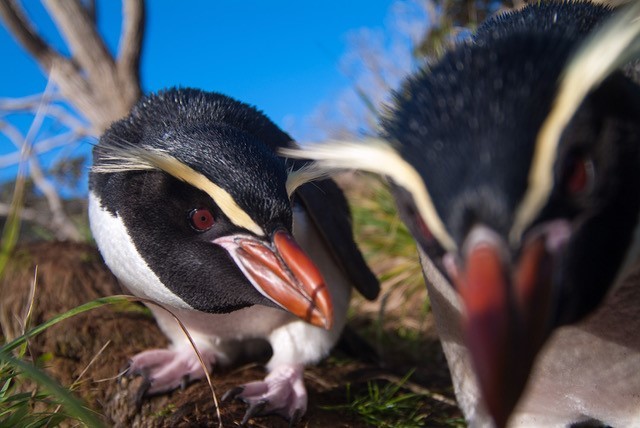Dr Nic Rawlence & Tess Cole, University of Otago
Australian politics is mired in a duel-citizenship scandal. Certain politicians have discovered that they are in fact part kiwi and accusations of interference in Australian politics are flying. This trans-Tasman identity shock, however, is not unique to Australian politicians. Now new ancient DNA research has surprisingly shown it’s also found in Australia’s penguins as well.
I was lucky enough to be part of an international team, led by University of Otago Zoology PhD candidate (and emigrated Australian) Tess Cole, which included collaborators from CSIRO (Australia), Landcare Research Manaaki Whenua and the Museum of New Zealand Te Papa Tongarewa, that has just shown the extinct Australian Hunter Island Penguin (Tasidyptes hunteri) is in fact part kiwi. No entry to the Australian penguin parliament for this bird. This is a big deal as there are only 11 varieties of penguins known from mainland Australia’s geological record, of which the Fairy Penguin is the only species around today. Some of its extinct cousins were true giants. Australians also love their penguins. Fairy Penguins are a major tourist drawcard and the subject of intense conservation efforts. So how did this trans-Tasman identity shock come about?
In the early 1980’s archaeologists excavating a cave on Hunter Island, off the northwest coast of Tasmania, discovered a jumble of bones from multiple different layers within the site. After careful study, they described these penguin bones as belonging to a genus and species of uniquely Australian penguin brand new to science, the Hunter Island Penguin (Tasidyptes hunteri), a close cousin to the more widespread crested penguins (Eudyptes spp.). This was a big call, based on such a small sample size of fragmentary bones, some of which were from juvenile individuals. Later discoveries of penguin bones in Tasmania were also assigned to this new penguin.
But not everyone was happy. Palaeontologists quickly started to question the citizenship status of the Hunter Island Penguin, arguing that the bones were most likely just those of penguins around today and nothing new, given the young age of the bones (they had been radiocarbon dated to around 500 years old). So, that is where the story ended, given the fragmentary nature of the bones made it difficult to reassess its citizenship status based on differences in bone shape and ‘bumps on bones’.
Enter ancient DNA on stage left. As part of a study led by our research group into the impacts of humans on crested penguins through time, we decided to do some further digging into the murky citizenship status of the Hunter Island Penguin. Collaborators at the Australian National Wildlife Collection, at CSIRO in Canberra, kindly let us drill holes into these precious specimens to collect samples for ancient DNA analysis. Remember, until proved otherwise, the bones of the Hunter Island Penguin are the only known examples of this unique species.

Ancient DNA giveth (Poūwa, Kōhatu Shag) and ancient DNA taketh away. We were expecting the bones of the Hunter Island Penguin to belong to species still around today, but we never expected them to represent three different penguin species, a so called ‘Frankenpenguin’: the Fairy penguin (Eudyptula novaehollandiae), Tawaki/Fiordland Crested Penguin (Eudyptes pachyrhynchus) and Snares Crested Penguin (Eudyptes robustus).
Fairy penguins are common around southern Australia, with populations on Philip Island near Melbourne, Granite and Kangaroo Islands near Adelaide, and Tasmania, so finding the bones of this bird in Tasmanian archaeological deposits is not all that surprising. But what about Tawaki and Snares Crested Penguin. How did they end up on the Apple Isle?
As with any marine animal, populations are concentrated in a given geographic area with vagrant individuals commonly seen in other areas. ‘Happy Feet’ the Emperor Penguin that arrived in New Zealand in 2011 is one such famous example. Vagrants are common in the archaeological record too. Our group has found vagrant Yellow-eyed Penguins in New Zealand prior to the extinction of Waitaha Penguin. Scientists have attached GPS trackers to Tawaki and Snares Crested Penguins and shown that during non-breeding times they like to hang out in waters south of Tasmania. These two crested penguin species occasionally turn up on Tasmanian beaches, so it’s no surprise that these penguins may have ended up on the menu.
Just like the Australian parliament may soon be bereft of another politician, the Hunter Island Penguin has been kicked out of the penguin parliament by a bunch of New Zealander’s masquerading as Australians – its status as uniquely Australian relegated to the history books. While ancient DNA can provide glimpses into lost worlds and vanished lives, it is also a powerful tool at solving these intricate taxonomic riddles. Until the next one…
Featured image: Snares Crested Penguins are one of the species identified using ancient DNA masquerading as the Hunter Island Penguin. Photo credit Thomas Mattern.

